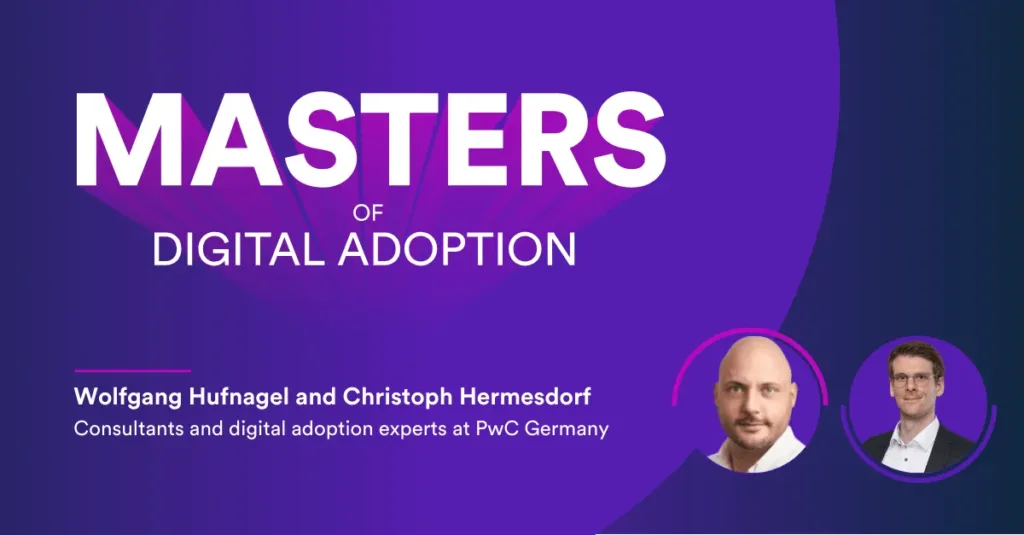How to build a user enablement journey

We recently interviewed the founding members of the PwC digital enablement team to explore how organizations can achieve a digital adoption mindset. We spoke with Wolfgang Hufnagel, and Christoph Hermesdorf, both management consultants and digital adoption experts.

Are clients considering digital adoption enough?
Christoph:
We are seeing more and more customers getting serious about digital adoption, but many are still in the early stages of their journey and so there are challenges we are facing together with them. For example, the question of when change management and digital adoption should start in a typical project lifecycle. In the old world, this topic only gets attention when it comes to putting out fires and therefore tends to be reactive instead of proactive.
Wolfgang:
As is the case with almost all digital transformation, successful digital adoption happens when two aspects are considered: technology and mindset.
On the technological side, digital adoption of new systems can be supported with the many well thought out tools that are emerging in the market. However concentrate only on said tools, and all you will end up doing is trying to explain technology with even more technology. This is where the mindset part comes into play. Your people need to be ready and excited for a new system before they can use digital adoption tools to their full potential. This is how technological and mindset aspects interplay in digital adoption.
What common pitfalls businesses experience on their digital adoption journeys?
Christoph:
For example, companies often view the introduction of a new ERP system as a mere tool implementation and thus as an isolated event within the company. However, such projects are often no less than a complex business transformation and require a complete rethinking of tools, processes, and mindset. Not only do interfaces change, but the roles of the people involved also do. To define new processes and roles, decision-makers must be explicitly empowered.
Wolfgang:
Additionally, too many organizations feel enablement or training is something that only needs to be considered right before go-live. The opposite is true. At PwC we believe that an enablement journey starts the very second that a person learns about the upcoming change a project is going to expose them to. Implementing a new system is not as simple as just dropping it on your employees heads. You need to adjust your organizational structure and involve people in building your solution from the beginning. It really is about the holistic transformation of your business. If you are implementing new software, you need an organizational structure and a mindset that fits it.
Christoph:
Various sources show that around 70% of digital transformation projects fail because they do not sufficiently consider change management and digital adoption. A large part of this can also be traced back to a lack of confidence among users – confidence in their own ability to use a new tool and new processes, and confidence that they have help and support at hand. This confidence of users in their own abilities is the result of good and, above all, sustainable enablement.
What does a successful enablement journey look like?
Table of Contents
Never forget to consider the people and organizational aspects
Wolfgang:
At PwC Germany, we even divide our people and organizational teams according to this specific framework. We have the HR and IT people who are the system implementers – technical experts that set up the system the way the client wants it. We have our HR transformation people who are adapting the organization and processes to the new system. And then we have the change management team that tackles the mindset angle I mentioned.
Conduct stakeholder mapping
Christoph:
The first step is to find out who your relevant stakeholders are and how they feel about the changes. Everyone has different communication needs and different viewpoints. In a second step, we need to understand whether employees in a particular organization are more likely to look to their leaders for guidance or rely more on their peer group. This then translates into the communication formats chosen. The level of communication can be assessed based upon their interest in the project or their perceived power over a project. We then need a clear and unified vision for the project that is carried into the organization by the project team and to which all affected stakeholders can relate.
Build excitement with communication
Wolfgang:
If employees only have their first interaction with the system one month prior to go-live, then they are much less likely to get excited about it. If you build this enablement journey with your stakeholders over the duration of the project you will be able to build curiosity and excitement amongst users. An ERP system, for example, can take up to 4 years to implement, providing plenty of time for points of interaction with employees.
Prioritize Involvement
Christoph:
Involving the right people at the right time is key, and this will be informed by the upfront stakeholder mapping you conduct. It will ensure the key stakeholders, who will be those affected by the change and who will need to adopt new processes, are actively involved in making decisions.
Consider a blended learning approach
Wolfgang:
A successful enablement journey will not focus on a single type of intervention. If you only focus on classroom training then it will be a very one-sided conversation. You need to utilize all channels. We recommend the 70/20/10 rule; 10% of learning happens in classroom settings, 20% of learning happens in a social setting and 70% actually happens on the job. Your enablement journey needs to tackle all three of those aspects. There are different technologies that can support your users here, a Digital Adoption platform like Userlane is one of those.
Be transparent and realistic in communication
Wolfgang:
While positivity in communications is always appreciated, feedback is often that people prefer a more realistic approach. It isn’t always the case that a new system is going to save everyone tons of time right from the get go. Sometimes it can take a few months before these benefits are realized. An organization needs to be open about this and so employees and users are prepared for the reality of what is to come.

